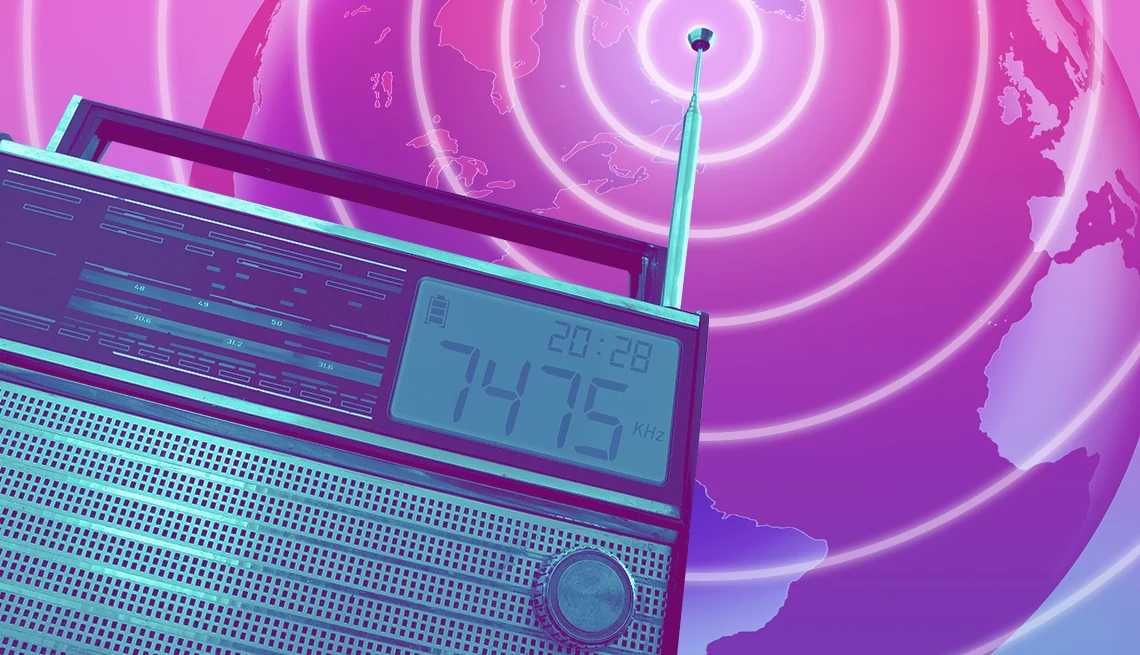
Does Anyone Use Shortwave Radio Anymore?
- Select a language for the TTS:
- UK English Female
- UK English Male
- US English Female
- US English Male
- Australian Female
- Australian Male
- Language selected: (auto detect) - EN
Play all audios:
Photo Collage: AARP; (Source: Getty Images (3)) Facebook Twitter LinkedIn
As a kid, I listened to overseas broadcasts via shortwave radio. Is shortwave still a thing?
Long before the internet turned shortwave radio into what some might perceive as an endangered species, I too was passionate about it. As a boy, I loved listening to broadcasts from halfway
around the world and hearing about foreign cultures and ideologies.
Shortwave is surely not what it was decades ago, but, yes, these radios still have a pulse. Concrete user numbers are hard to come by, but a relatively small community of shortwave diehards
remains active, many 50 and older.
A Shortwave Radio Listeners Club on Facebook has more than 21,300 members. Several websites are devoted to shortwave.
You can buy brand new radios without having to spend an arm and a leg and find stations to listen to — albeit not nearly as many as in shortwave’s heyday during the Cold War.
“Many of the big world services have stopped targeting North America in favor of the web or gone out of business entirely because they don’t want to spend the money,” says James Careless, a
shortwave enthusiast and Ottawa journalist. He’s also a frequent contributor to Radio World, an online site that caters to broadcast radio executives and engineers.
Shortwave allows youto listen to the world
As a young teen, I had a tabletop radio I could plug in or operate on batteries. By delicately twisting a dial across shortwave frequency bands — 3,000 to 30,000 kHz, the equivalent of 3 to
30 MHz — I tuned in stations such as Radio Netherlands and BBC.
Ask The Tech GuruAARP writer Ed Baig will answer your most pressing technology questions every Tuesday. Baig previously worked for USA Today, BusinessWeek, U.S. News & World Report and Fortune, and is author
of Macs for Dummies and coauthor of iPhone for Dummies and iPad for Dummies.
Have a question? Email [email protected]
Most intriguing were English-language propagandist Cold War broadcasts from Radio Havana, Radio Moscow and Radio Peking, later Radio Beijing, targeting “U.S. imperialists.” I resisted
brainwashing; I listened to Voice of America too.
I also remember getting a strong signal from HCJB out of Quito, Ecuador, and was thrilled when “The Voice of the Andes” sent me a QSL card in the mail, which acknowledged my own letter
telling them about my reception quality in Queens, New York. QSL is not an English acronym; instead it's one of many Q signals that radio operators use, this one to ask and acknowledge
receipt of a transmission.
Ask The Tech GuruAm I Locked Out of LinkedIn?What Can Smart Speakers Do?Recover Deleted Phone PhotosIs My Smart TV a Spy?Seminar: AI disinformationSee All TechGuru Columns
HCJB was a Christian missionary station — its call letters stood for Hoy Cristo Jesús Bendice and Heralding Christ Jesus’ Blessings in its initial languages of Spanish and English — and lots
of what you’ll stumble on shortwave nowadays still has a religious bent. But you’ll also hear propaganda, political talk and music, and at times amateur ham radio, says Jeff White, general
manager and founder of WRMI Radio Miami International, based in Okeechobee, Florida.
WRMI has 14 transmitters and is the largest privately owned shortwave station in the Western Hemisphere. It broadcasts its own programs but also sells airtime to outside organizations and
relays or boosts shortwave signals from other countries.